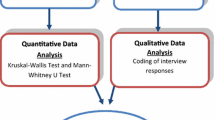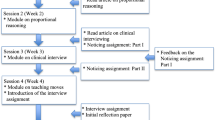Abstract
Listening to students' mathematical thinking is one of the trademarks of reform-minded visions of mathematics teaching. The questions of when, where, how, and what might help prospective teachers learn to do so,however, remain open. This study examines how a mathematics letter exchange with Grade 4 students provided an occasion for prospective teachers to learn about students' mathematical thinking and to examine their interpretive practices. Analysis of the interactions between students and prospective teachers, and of the reflective writing of the latter,revealed changes in the patterns of their interpretations. I characterized these as changes in the focus of interpretation, from correctness to meaning, and in the interpretive approach, from quick and conclusive to thoughtful and tentative. I also discuss factors associated with these interpretive turns.
Similar content being viewed by others
REFERENCES
Anderson, J. (1992). Journal writing: The promise and the reality. Journal of Reading, 36, 304–309.
Ball, D.L. (1988). Unlearning to teach mathematics. For the Learning of Mathematics, 8(1), 40–48.
Ball, D.L. (1990). Breaking with experience in learning to teach mathematics: The role of a preservice methods course. For the Learning of Mathematics, 10(2), 10–16.
Ball, D.L. (1993). With an eye on the mathematical horizon: Dilemmas of teaching elementary school mathematics. The Elementary School Journal, 93, 371–397.
Ball, D.L. (1994, November). Developing mathematics reform: What don't we know about teacher learning - but would make good working hypotheses? Paper presented at the conference on Teacher Enhancement K-6, Arlington, VA.
Ball, D.L. Chazan, D. (1994). An examination of teacher telling in constructivist mathematics pedagogy: Not just excusable but essential. Unpublished manuscript. East Lansing: Michigan State University. [Cited with author's permission].
Brophy, J. Good, T. (1974). Teacher-student relationships: Causes and consequences. New York: Holt, Reinhart, and Winston.
Brown, J.S., Collins, A. Duguid, P. (1989). Situated cognition and the culture of learning.Educational Researcher, 18(1), 32–42.
Burns, M. (1987). A collection of math lessons: From grades 3 through 6. Sausalito, CA: Math Solutions Publications.
Cobb, P. (1988). The tension between theories of learning and instruction in mathematics education. Educational Psychologist, 23, 87–103.
Crespo, S. (1998). Math penpals as a context for learning to teach: A study of preservice teachers’ learning. Dissertation Abstracts International 59-05A: 1530.
Davis, B. (1996). Teaching mathematics: Toward a sound alternative. New York: Garland Publishing.
Duckworth, E. (1987). The having of wonderful ideas (and other essays on teaching and learning). New York: Teachers College Press.
Feiman-Nemser, S. Buchmann, M. (1986). Pitfalls of experience in teacher preparation. In J. Raths L. Katz (Eds.), Advances in teacher education, Vol. 2 (pp. 61–73). Norwood, NJ: Albex.
Good, T. (1987). Two decades of research on teacher expectations: Findings and future directions. Journal of Teacher Education, 38, 32–47.
Holt-Reynolds, D. (1995, April). Learning teaching, teaching teachers. Paper presented at The Annual Meeting of the American Educational Research Association, New Orleans.
Kamii, C. (1989). Young children continue to re-invent arithmetic: Implications of Piaget's theory. New York: Teachers College Press, Columbia University.
Maher, C.A. Davis, R.A. (1990). Teacher's learning: Building representations of children's meanings. Journal for Research in Mathematics Education (Monograph No. 4), 79–90.
National Council of Teachers of Mathematics (1991). Professional standards for teaching mathematics. Reston, VA: Author.
Nicol, C. (1997). Learning to teach prospective teachers to teach mathematics. Dissertation Abstracts International 58-06A: 2168.
Phillips, E. Crespo, S. (1996). Developing written communication in mathematics through math penpals. For the Learning of Mathematics, 16(1), 15–22.
Richert, A.E. (1992). The content of student teachers’ reflections within different structures for facilitating the reflective process. In T. Russel H. Munby (Eds.), Teachers and teaching: From classroom to reflection (pp. 171–191). London: Falmer Press.
Schön, D.A. (1983). The reflective practitioner: How professionals think in action. New York: Basic Books.
Smith, J.P. (1996). Efficacy and teaching mathematics by telling: A challenge for reform. Journal for Research in Mathematics Education, 27, 387–402.
Wassermann, S. (1993). Getting down to cases: Learning to teach with case studies. New York: Teachers College Press.
Wilson, S. (1990). The secret garden of teacher education. Phi Delta Kappan, 72, 204–209.
Author information
Authors and Affiliations
Rights and permissions
About this article
Cite this article
Crespo, S. Seeing More Than Right and Wrong Answers: Prospective Teachers' Interpretations of Students' Mathematical Work. Journal of Mathematics Teacher Education 3, 155–181 (2000). https://doi.org/10.1023/A:1009999016764
Issue Date:
DOI: https://doi.org/10.1023/A:1009999016764




